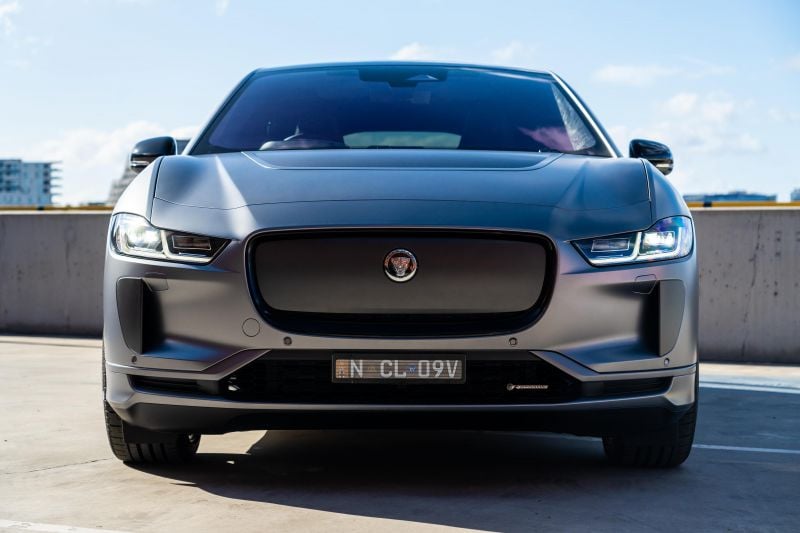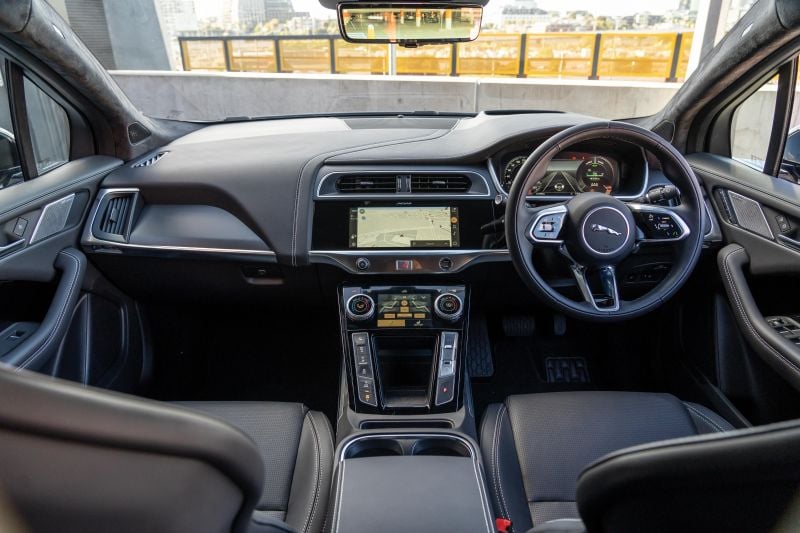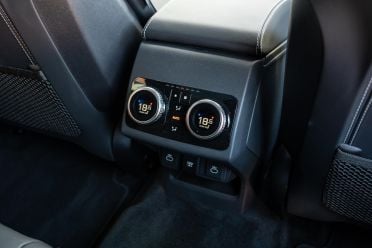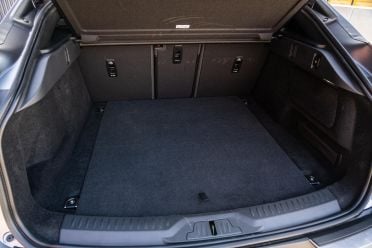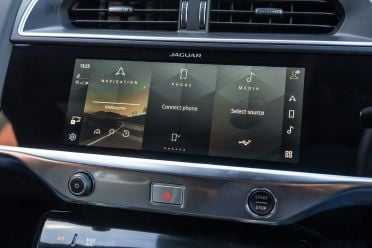It’s crazy to think that the Jaguar I-Pace is nearing its seventh birthday.
When it was revealed and subsequently launched at the tail-end of last decade, the British luxury brand was arguably ahead of its time with a high-performance electric crossover SUV built on a dedicated electric platform.
Now, seven years on, it still looks the business, thanks to a design that has aged beautifully with minimal changes since its inception. Despite this, the I-Pace is something of a bit player in Australia’s electric vehicle (EV) market.
To the end of October 2024, just nine new units have been registered in Australia, after Jaguar sold just 35 units for the entirety of 2023. By comparison, the pre-update Audi e-tron did almost seven times that volume last year.
So why is that the case?
WATCH: Paul’s video review of the 2022 Jaguar I-Pace
Well, Jaguar has been on a downward sales trend of late, as its niche luxury offerings near the end of their life cycles and the brand pivots to a dedicated EV lineup in the coming years.
Numerous range restructures and price adjustments haven’t helped, and it seems that more and more customers are just choosing German alternatives as a result.
That’s not to say the I-Pace is a ‘bad’ EV. In fact, it’s a pretty good thing. But, numerous price rises over the years, Jaguar’s tendency to make so much equipment optional, and a lot more competition sinch its launch no doubt plays a part in its slow sales.
In addition, the I-Pace is not immensely practical despite its size, because that swooping roofline impedes rear seat and boot space compared to some of its more pragmatic rivals.
But if you want something electric, and you desire something different, should the Jaguar I-Pace be on your shortlist? We spent a week with a concept-looking, matte-grey HSE-spec example to find out.
Note: Global production of the Jaguar I-Pace is coming to a close, but the British EV still remains available to order in Australia.
A spokesperson for JLR Australia told CarExpert: “There is sufficient stock in Jaguar retailers to carry us through to 2025, however, if a customer is wanting a specification that is outside what is available, the opportunity still exists to have it built”.

How much does the Jaguar I-Pace cost?
The two-variant I-Pace range in Australia starts from $147,475 plus on-road costs, while the top-spec R-Dynamic HSE on test here is nearly $20,000 dearer than the entry point at $165,075 before on-roads.
| Model | Price before on-road costs |
|---|---|
| Jaguar I-Pace EV400 R-Dynamic SE AWD | $147,475 |
| Jaguar I-Pace EV400 R-Dynamic HSE AWD | $165,075 |
To see how the Jaguar I-Pace lines up against the competition, check out our comparison tool
What is the Jaguar I-Pace like on the inside?
Even after all these years, I feel the I-Pace’s cockpit still looks pretty swish.
Jaguar has refined it with newer display tech over the years, but the general look and feel of the I-Pace’s cabin hasn’t changed much since it debuted last decade – and that’s not necessarily a bad thing.
The sweeping lines and racy seats really cocoon the front occupants, bolstered by the rising centre console bridge and concept car-like steering wheel to give off futuristic Speed Racer vibes.
It certainly all plays into Jaguar’s ‘made for the driver’ vibe. You feel like the I-Pace has been designed to be driven with enthusiasm, rather than just be a soulless A-to-B commuter.
While the swish specification of our press car is quite sexy and appealing, there are a number of elements that aren’t standard equipment, even on the flagship HSE version tested here.
For example, the extended leather trim, which sees natural hide adorn the dashboard and doors, is a $2760 option, which is a lot even if it really helps to elevate the ambience. Further, the 14-way electrically adjustable front seats with heating, cooling and memory functions costs an additional $2040.
We’re not done yet either – the ClearSight digital rear-view mirror seen here is a cool $1130 option; four-zone climate control costs $1130 extra; and even privacy glass is an extra-cost option ($850!).
For reference, our test car had just under $20,000 of options based on MY24 pricing (the latest cars are MY24.5), though about half of that is the pricey $9050 Eiger Grey exterior paint with satin finish. Still, the fact the Dynamic Pack ($7411) is required to add adaptive damping and air suspension to a vehicle this expensive seems a bit rude.
All things considered though, the rest of the cabin has done well to stand the test of time, including the lashings of metallic accents contrasted with gloss-black surfaces, and the neat technology integration including the digital climate control pod. The push-button shift selector isn’t my favourite, though.
The displays are pretty enough, but aren’t groundbreaking in the current landscape, as the Germans have larger screen real estate, higher resolution and faster processing. Still, the Pivi Pro interface is very easy to use and does the job well.
Wireless Apple CarPlay worked seamlessly during my time with the I-Pace, and I like that the 12.3-inch digital instrument cluster rivals brands like Audi and Mercedes-Benz for configurability. I’d probably pass on the digital rear-view mirror though, since there’s no need to spend over $1000 on this.
Nonetheless, the I-Pace’s age is betrayed by the inconsistencies of its storage design. Unlike newer dedicated EVs, storage space optimisation doesn’t appear to have been as much of a priority for Jaguar.
There’s a shallow cubby under the centre console and a slot for the key ahead of the dual cupholder setup. The centre storage cubby under the armrest is decent, but the bottle holders in the doors are likewise shallow.
Space in the second row isn’t quite as good as you might expect for a crossover this large, and it’s not helped by the sloping coupe-like roofline. While it’s an ‘SUV’ of sorts, this is more of an enlarged hatchback with a sportback-style tailgate at that.
That said, at 6’1″, I can sit behind my preferred driving position with only my hair brushing the roof.
Forward visibility from the rear is pretty well hampered by the bulky front bucket seats though, and the tapered roofline means a tapered windowline too – something to consider if you have smaller kids prone to car sickness.
Standard rear-seat amenities include pillar-mounted ventilation, rear charging ports and map pockets behind the front seats, as well as a fold-down centre armrest with cupholders. Our tester was fitted with optional four-zone climate control, which adds $1820 – a bit stiff, given this is a $165,000 luxury car.
For those carrying children often, there’s the requisite ISOFIX and top-tether child seat anchor points in the rear.
Behind the rear seats, Jaguar quotes 656 litres of cargo capacity with the second row in use and 1453 with them folded. As you can see in the image above, the seats don’t really stow flat when folded.
| Dimensions | Jaguar I-Pace EV400 |
|---|---|
| Length | 4682mm |
| Width | 2011mm |
| Height | 1566mm |
| Wheelbase | 2990mm |
| Cargo capacity | 656-1453 litres |
To see how the Jaguar I-Pace lines up against the competition, check out our comparison tool
What’s under the bonnet?
Just one dual-motor, all-wheel drive powertrain is offered in the I-Pace, dubbed EV400.
| Specifications | Jaguar I-Pace EV400 |
|---|---|
| Drivetrain | Dual-motor electric |
| Battery | 90kWh li-ion |
| Power | 294kW |
| Torque | 696Nm |
| Driven wheels | All-wheel drive |
| Weight | 2133kg |
| 0-100km/h (claimed) | 4.8 seconds |
| Claimed range | 446km – NEDC |
| Max AC charge rate | 7.2kW |
| Max DC charge rate | 104kW |
To see how the Jaguar I-Pace lines up against the competition, check out our comparison tool
How does the Jaguar I-Pace drive?
Jaguars have long been about the driving experience, and the I-Pace remains one of the nicest EV crossovers to pilot.
Despite its age, the I-Pace drives and handles as well as many of its more modern rivals, offering eager throttle response and pretty keen handling for a family-sized crossover that weighs over 2.1 tonnes.
It sort of shrinks around you and doesn’t really feel as big as it is, save for width when navigating tighter city streets, and the quick steering makes it feel pretty pointy.
Even in its more sedate drive modes, the I-Pace is pretty punchy. Jaguar claims a 0-100km/h sprint time of 4.8 seconds, which not long ago was the realm of Mercedes-AMG and BMW M products.
It certainly feels that quick when you sink your boot in, but this Big Cat is a relatively silent killer. You can have it with some form of synthesised powertrain noise to augment the sensation of accelerating, but you can also switch it off.
Either way, the I-Pace thrusts forward under throttle and can really shove you back in your seat. All 696Nm being available from rest might have something to do with that.
Even with its muscular torque response, the I-Pace piles on pace with the sort of linearity and refinement that eliminates the feeling of spikiness or jolting that some rival EVs with touchy throttles can have.
It allows you to drive this car very smoothly and normally in everyday scenarios, and it can very effortlessly get you from point A to B while also bringing a sense of engagement and enjoyment through those connected controls.
Despite its heftier weight, the I-Pace’s low centre of gravity and responsive steering gives it a more athletic character than rivals like the Audi Q8 e-tron and Mercedes-Benz EQE SUV.
Combined with the driver-oriented cockpit and racy seats, it gives the I-Pace a very sporty feel – but it’s still a big car.
While more sport-leaning and riding on big 22-inch alloy wheels shod in low-profile tyres as tested, the I-Pace actually rides fairly well over pockmarked city streets, at least with its optional adaptive air suspension.
That said, it still errs on the firmer side, meaning it still communicates most road surface irregularities into the cabin, but it’s far from jarring or unsettled. Only over really sharp hits does it ever thud or slap, but the tradeoff is good grip and a planted stance at all times.
Insulation from wind and road noise is generally pretty good, but those larger wheels and performance tyres can let in a little more tyre roar than you might like in your luxury SUV on coarser black-top.
Perhaps one aspect of the I-Pace’s drive experience that betrays its advancing age is the driving range. Jaguar’s claim of 446km on the much more lenient NEDC test protocol will translate to 400km or a little under in the real world.
We saw indicated energy consumption of 20-22kWh/100km across a variety of conditions, and after occasionally selecting Eco mode, which dulls throttle response and drops the suspension height for better aero efficiency.
That’s not too bad compared to direct rivals, but the I-Pace’s smaller battery pack means less outright range, and the relatively slow DC charge rate of 104kW means you can’t make the best use of ultra-fast DC chargers if you happen to stumble across one in your travels.
It’s also well behind the competition, with rivals like the Mercedes-Benz EQE SUV capable of taking DC rates of up to 170kW, while the new Porsche Macan Electric can handle up to 270kW.
Further, AC charging is capped at 7.2kW, which is down on the 11-22kW capacities offered by rivals if you have access to a three-phase wallbox.
As for driver assistance systems, Jaguar’s suite of features is actually pretty good.
The semi-autonomous highway function combines adaptive cruise and lane centring functions to take the load off highway stints, and it does the job in a very natural and human-like manner – no jolting of the steering here.
Blind-spot monitoring and rear cross-traffic alert are also good to have, given the I-Pace’s rising shoulder line and thick rear pillars, but there’s one glaring omission I cannot forgive – the surround camera is a $1000 option!
Yes, you have to pay extra on this top-spec Jaguar for a surround camera. Madness. Plus, the standard reversing camera is average at best, although front and rear parking sensors are helpful.
To see how the Jaguar I-Pace lines up against the competition, check out our comparison tool
What do you get?
There are two key specification levels in Australia – SE and HSE.
I-Pace R-Dynamic SE highlights:
- 20-inch alloy wheels
- LED headlights incl. auto high beam
- LED tail-lights, rear fog lights
- 12.3-inch digital instrument cluster
- 10-inch Pivi Pro touchscreen
- Amazon Alexa integration
- Satellite navigation
- Wireless Apple CarPlay, Android Auto
- Wireless smartphone charger
- DuoLeather leatherette upholstery
- 12-way power adjust front seats incl. memory
- Leather steering wheel
- 6-speaker audio
- Dual-zone climate control
- Keyless entry, start
- Electric tailgate
- ‘JAGUAR’ Metal sill plates
- Auto-dimming rear-view mirror
- Ambient interior lighting
- All Surface Progress Control
- Power folding, heated side mirrors
- Memory function
- Courtesy lighting
- Auto-dimming driver mirror
I-Pace R-Dynamic HSE adds:
- 20-inch alloy wheels – alternate design
- Matrix LED headlights incl. dynamic indicators
- Windsor leather upholstery
- 16-way power-adjust front seats
- Heated, cooled
- Memory function
- Heated rear seats
- Suede headliner – black
- Head-up display
- 15-speaker Meridian 3D surround sound
To see how the Jaguar I-Pace lines up against the competition, check out our comparison tool
Option
A number of packages and single-item options are available for the Jaguar I-Pace – below are some of the main ones.
Cold Climate Pack: $1658
- Heated windscreen
- Heated washer jets
- Heated steering wheel
- Front fog lights
- Headlight power wash
Convenience Pack: $1403
- Surround camera system
- Semi-autonomous park assist
Dynamic Pack: $7411
- Electronic air suspension
- Adaptive Dynamics
- 22-inch alloy wheels – Gloss Black
- Tailgate spoiler
- JaguarDrive Control with Adaptive Surface Response
Is the Jaguar I-Pace safe?
The I-Pace comes with a five-star ANCAP safety rating based on 2018 Euro NCAP tests.
| Category | Jaguar I-Pace |
|---|---|
| Adult occupant protection | 33 out of 38 (86 per cent) |
| Child occupant protection | 44 out of 49 (89 per cent) |
| Vulnerable road user protection | 37.63 out of 54 (69 per cent) |
| Safety assist | 13.49 out of 16 (84 per cent) |
Standard safety features include:
- 6 airbags
- Adaptive cruise control
- Autonomous emergency braking (AEB)
- Blind-spot monitoring
- Door exit warning
- Lane keep assist
- Parking sensors – front, rear
- Rear cross-traffic alert
- Reversing camera
- Traffic sign recognition
- Tyre pressure monitoring
To see how the Jaguar I-Pace lines up against the competition, check out our comparison tool
How much does the Jaguar I-Pace cost to run?
Jaguar offers a five-year, unlimited-kilometre warranty across its range, with EV traction batteries warranted for eight years or 160,000 kilometres – and a minimum of 70 per cent health guaranteed during that period.
| Running costs | Jaguar I-Pace |
|---|---|
| Warranty | 5 years, unlimited kilometres – new vehicle 8 years or 160,000 kilometres – EV battery |
| Roadside assistance | Up to 7 years – service activated |
| Service intervals | 12 months or 15,000 kilometres |
| Capped-price servicing | 5 years or 200,000 kilometres |
| Total capped-price service cost | Complimentary |
To see how the Jaguar I-Pace lines up against the competition, check out our comparison tool
CarExpert’s Take on the Jaguar I-Pace
This electric Big Cat is headed for extinction, and while she’s still a beauty on the outside there are a number of elements that are really showing their age in 2024.
Particularly in HSE specification, the high asking price is oddly accompanied by a litany of extra-cost options that should really be standard, and its driving range and charging speeds are behind the pack.
Our tester was priced at well over $180,000 as tested, and closer to $200,000 once on the road. While its matte paint makes it looks like a sexy concept car, that kind of money could buy you much newer, cooler electrified metal. Similar coin can buy you an Audi e-tron GT or an entry-level Porsche Taycan, for example.
That’s not to say the I-Pace doesn’t have its strengths, though. Beyond its slinky silhouette, it also has a cool cabin design that can be dressed up to feel pretty special, it drives more like a electric ‘car’ than ‘SUV’, and there’s exclusivity that comes with its niche sales volume.
You could also argue the I-Pace is a piece of significant automotive history. The I-Pace was a trailblazer at launch in 2018, and signalled a new era for the Jaguar brand. The better part of a decade on, it’s still a lovely thing.
In its final form, it has all the best of Jaguar’s latest in-car and assistance technology advancements, while also keeping some of that unique British luxury car essence that exudes character in a way the Germans and Tesla do not.
If you can get a good deal on one – and I mean a good deal – there’s plenty of reason to buy a well-specified I-Pace over an Audi Q8 e-tron or Mercedes-Benz EQE SUV. I’d probably take one over a BMW iX as well.
Like most Jaguar Land Rover (or JLR) products though, the appeal of the I-Pace can be entirely based on spec. Save $20,000 off retail and start with the SE, then add a couple of choice options and opt for more expressive colours inside and out, and you have something truly unique.
Get in quick if you want one, though. With production winding down, it’ll only be available while stocks last… and there doesn’t seem to be a lot of stock left according to Jaguar’s website.
Rest in power…
Interested in buying a Jaguar I-Pace? Get in touch with one of CarExpert’s trusted dealers here
Click the images for the full gallery
MORE: Everything Jaguar I-Pace












